《英语诗歌欣赏》小论文范文
诗歌鉴赏类英语作文范文
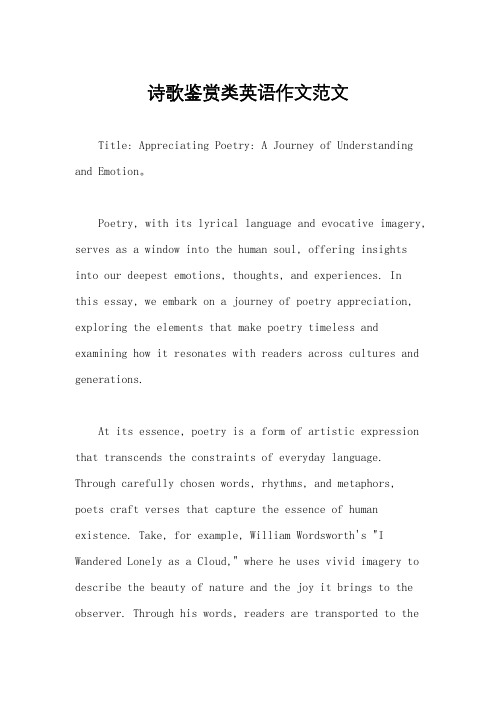
诗歌鉴赏类英语作文范文Title: Appreciating Poetry: A Journey of Understanding and Emotion。
Poetry, with its lyrical language and evocative imagery, serves as a window into the human soul, offering insights into our deepest emotions, thoughts, and experiences. Inthis essay, we embark on a journey of poetry appreciation, exploring the elements that make poetry timeless and examining how it resonates with readers across cultures and generations.At its essence, poetry is a form of artistic expression that transcends the constraints of everyday language. Through carefully chosen words, rhythms, and metaphors, poets craft verses that capture the essence of human existence. Take, for example, William Wordsworth's "I Wandered Lonely as a Cloud," where he uses vivid imagery to describe the beauty of nature and the joy it brings to the observer. Through his words, readers are transported to thetranquil meadows and azure skies, experiencing a sense of wonder and awe akin to the poet's own.One of the most captivating aspects of poetry is its ability to evoke emotions in the reader. Whether it's love, longing, sadness, or joy, poetry has the power to stir the deepest recesses of our hearts. Consider the haunting beauty of Edgar Allan Poe's "The Raven," with its melancholic refrain of "Nevermore." Through Poe's masterful use of symbolism and repetition, readers are drawn into the narrator's despair, feeling the weight of his grief and loss. Such is the power of poetry to transcend time and space, connecting us to the universal experiences of humanity.Moreover, poetry serves as a reflection of the cultural and historical context in which it is written. From the ancient epics of Homer to the modernist experiments of T.S. Eliot, each poetic work bears the imprint of its era, offering valuable insights into the values, beliefs, and concerns of society at that time. For instance, Langston Hughes' "Harlem" captures the disillusionment andfrustration of African Americans during the Harlem Renaissance, expressing the deferred dreams and aspirations of a marginalized community. Through his poignant verses, Hughes gives voice to the struggles and aspirations of an entire generation, making poetry not just a form ofartistic expression but also a powerful tool for social commentary and change.In addition to its emotional and cultural resonance, poetry also challenges readers to engage with language in new and unexpected ways. Unlike prose, which follows conventional grammatical rules and narrative structures, poetry often defies convention, playing with form, rhythm, and sound to create meaning. Consider the experimental poetry of e.e. cummings, where words are stripped of their conventional meanings and arranged in unconventional patterns to evoke emotions and sensations. Through his playful manipulation of language, cummings invites readers to experience the world anew, challenging them to question their preconceived notions and embrace the beauty of ambiguity and uncertainty.In conclusion, poetry is a multifaceted art form that enriches our lives in myriad ways. From its ability toevoke emotions and provoke thought to its capacity for cultural expression and linguistic innovation, poetry continues to captivate and inspire readers across the globe. As we immerse ourselves in the timeless verses of the poets, we embark on a journey of self-discovery and enlightenment, finding solace, meaning, and beauty in the rhythmic cadence of words.。
诗歌欣赏英文作文高中范文
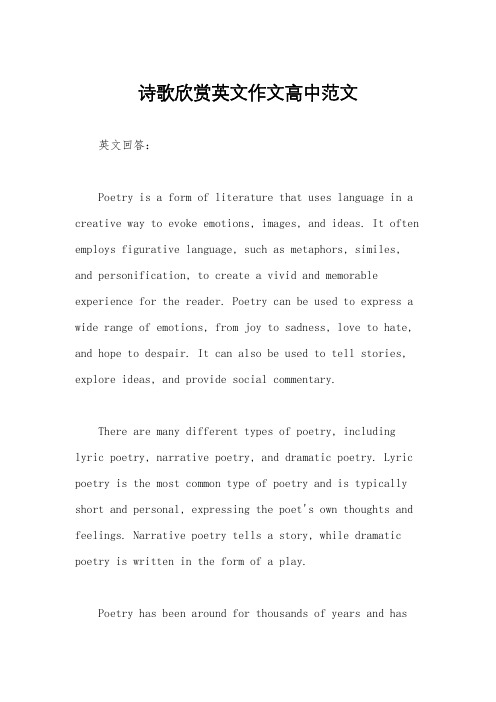
诗歌欣赏英文作文高中范文英文回答:Poetry is a form of literature that uses language in a creative way to evoke emotions, images, and ideas. It often employs figurative language, such as metaphors, similes, and personification, to create a vivid and memorable experience for the reader. Poetry can be used to express a wide range of emotions, from joy to sadness, love to hate, and hope to despair. It can also be used to tell stories, explore ideas, and provide social commentary.There are many different types of poetry, including lyric poetry, narrative poetry, and dramatic poetry. Lyric poetry is the most common type of poetry and is typically short and personal, expressing the poet's own thoughts and feelings. Narrative poetry tells a story, while dramatic poetry is written in the form of a play.Poetry has been around for thousands of years and hasbeen practiced in every culture. Some of the most famous poets include William Shakespeare, John Keats, Emily Dickinson, and Walt Whitman. Poetry continues to be a popular form of literature today, and there are many contemporary poets who are writing and publishing new work.中文回答:诗歌是一种文学形式,通过创造性地使用语言来唤起情感、意象和思想。
英文诗篇赏析作文范文初中
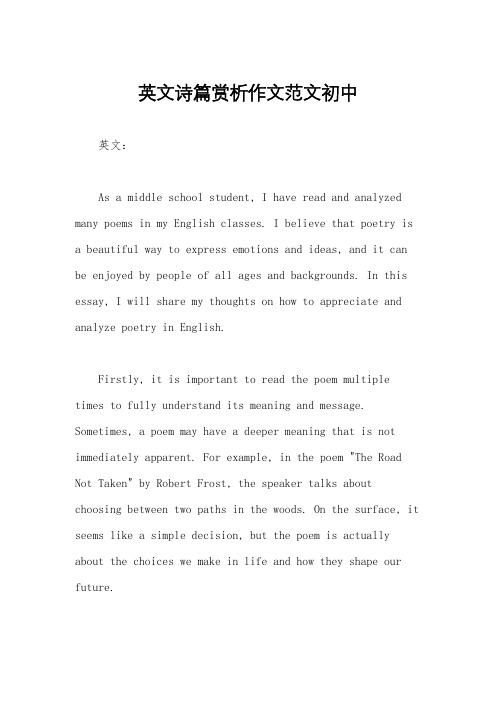
英文诗篇赏析作文范文初中英文:As a middle school student, I have read and analyzed many poems in my English classes. I believe that poetry is a beautiful way to express emotions and ideas, and it can be enjoyed by people of all ages and backgrounds. In this essay, I will share my thoughts on how to appreciate and analyze poetry in English.Firstly, it is important to read the poem multiple times to fully understand its meaning and message. Sometimes, a poem may have a deeper meaning that is not immediately apparent. For example, in the poem "The Road Not Taken" by Robert Frost, the speaker talks about choosing between two paths in the woods. On the surface, it seems like a simple decision, but the poem is actually about the choices we make in life and how they shape our future.Secondly, it is helpful to identify the literary devices used in the poem. These can include similes, metaphors, personification, and imagery. By recognizing these devices, we can better understand the poet'sintention and the emotions they are trying to convey. For instance, in the poem "I Wandered Lonely as a Cloud" by William Wordsworth, the speaker compares himself to a cloud to describe his sense of isolation and loneliness.Lastly, it is important to consider the historical and cultural context of the poem. Many poets are influenced by the events and ideas of their time, and this can be reflected in their work. For example, Langston Hughes was a prominent African American poet during the Harlem Renaissance, and his work often addressed issues of race and identity.中文:作为一名初中生,在英语课上我阅读并分析了许多英文诗歌。
赏析英文诗歌推荐作文范文
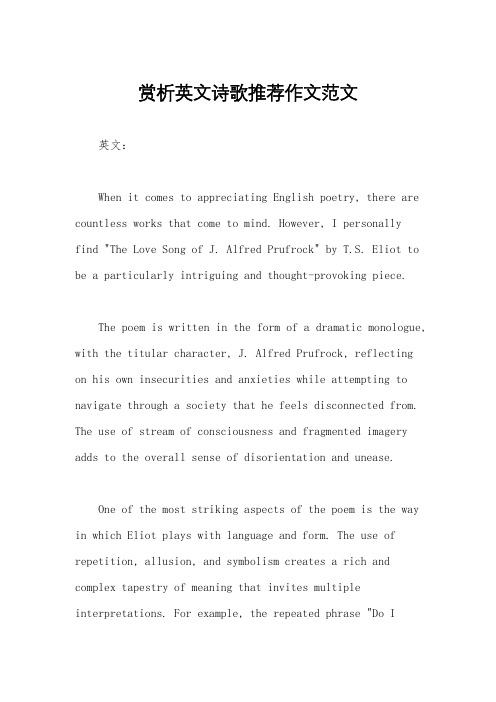
赏析英文诗歌推荐作文范文英文:When it comes to appreciating English poetry, there are countless works that come to mind. However, I personallyfind "The Love Song of J. Alfred Prufrock" by T.S. Eliot to be a particularly intriguing and thought-provoking piece.The poem is written in the form of a dramatic monologue, with the titular character, J. Alfred Prufrock, reflecting on his own insecurities and anxieties while attempting to navigate through a society that he feels disconnected from. The use of stream of consciousness and fragmented imagery adds to the overall sense of disorientation and unease.One of the most striking aspects of the poem is the way in which Eliot plays with language and form. The use of repetition, allusion, and symbolism creates a rich and complex tapestry of meaning that invites multiple interpretations. For example, the repeated phrase "Do Idare?" suggests a sense of hesitation and uncertainty,while the allusions to Dante's "Inferno" and Shakespeare's "Hamlet" add layers of historical and literary significance.Overall, "The Love Song of J. Alfred Prufrock" is a masterful example of modernist poetry that continues to captivate and challenge readers to this day.中文:谈到欣赏英文诗歌,脑海中浮现的作品数不胜数。
英文诗歌欣赏的英语作文

英文诗歌欣赏的英语作文英文:When it comes to appreciating English poetry, I believe it is important to first understand the language and the cultural context in which the poem was written. This can be achieved through reading and analyzing the poem, as well as researching the historical and cultural background of the poet and the time period in which the poem was written.One poem that I particularly enjoy is "The Waste Land" by T.S. Eliot. This poem is a complex and multi-layered work that requires careful analysis and interpretation. Through reading and researching the poem, I was able to gain a deeper understanding of the themes and motifs that Eliot was exploring, such as the breakdown of traditional values and the fragmentation of modern society.In addition to analyzing the poem itself, I also find it helpful to read and analyze critical essays and articleswritten about the poem. This can provide valuable insights and perspectives that may not have been immediately apparent to me upon first reading the poem.Ultimately, I believe that appreciating English poetry requires a combination of careful analysis and interpretation, as well as an openness to exploring the cultural and historical context in which the poem was written.中文:我认为欣赏英文诗歌,首先需要理解诗歌所处的语言和文化背景。
诗歌欣赏英文作文初中

诗歌欣赏英文作文初中英文:Poetry is a form of art that has been around for centuries, and it is still widely appreciated today. It is a way for people to express themselves in a creative and meaningful way, using language to evoke emotions and paint vivid pictures in the minds of their readers. I personally enjoy reading and analyzing poetry because it allows me to delve deeper into the meaning behind the words and appreciate the skill and craftsmanship that goes into creating a well-crafted poem.One of my favorite poems is "The Road Not Taken" by Robert Frost. This poem speaks to me on a personal level because it reminds me of the choices we all have to make in life and how those choices can shape our future. The lines "Two roads diverged in a wood, and I— I took the one less traveled by, And that has made all the difference" resonate with me because I believe that sometimes taking the lesspopular or more difficult path can lead to greater rewards and personal growth.Another poem that I find particularly powerful is Maya Angelou's "Still I Rise". This poem is a celebration of resilience and overcoming adversity, and it inspires me to keep pushing forward even when faced with challenges. The lines "You may shoot me with your words, You may cut me with your eyes, You may kill me with your hatefulness, But still, like air, I'll rise" are a powerful reminder that we are capable of rising above the negativity and hatefulness of others.中文:诗歌是一种已经存在了数百年的艺术形式,今天仍然被广泛赞赏。
英语诗歌鉴赏的英文作文
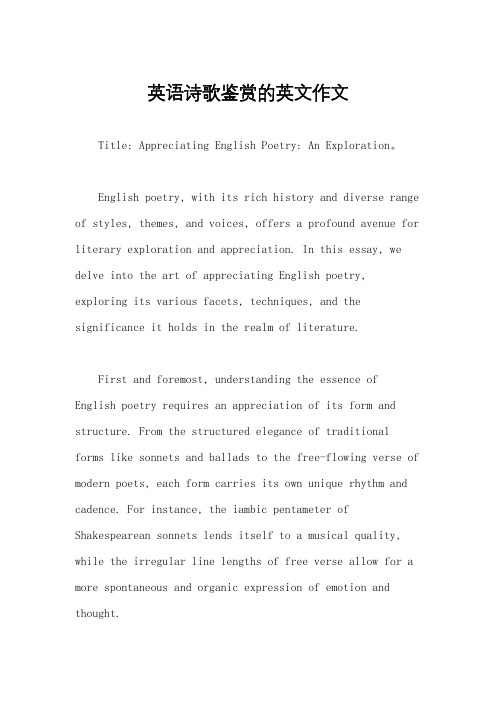
英语诗歌鉴赏的英文作文Title: Appreciating English Poetry: An Exploration。
English poetry, with its rich history and diverse range of styles, themes, and voices, offers a profound avenue for literary exploration and appreciation. In this essay, we delve into the art of appreciating English poetry, exploring its various facets, techniques, and the significance it holds in the realm of literature.First and foremost, understanding the essence of English poetry requires an appreciation of its form and structure. From the structured elegance of traditional forms like sonnets and ballads to the free-flowing verse of modern poets, each form carries its own unique rhythm and cadence. For instance, the iambic pentameter of Shakespearean sonnets lends itself to a musical quality, while the irregular line lengths of free verse allow for a more spontaneous and organic expression of emotion and thought.Beyond form, the language of English poetry is imbued with layers of meaning and imagery, often requiring careful analysis to fully grasp its nuances. Poets employ a variety of literary devices such as metaphor, simile, personification, and symbolism to evoke sensory experiences and convey abstract concepts. For instance, in William Wordsworth's "I Wandered Lonely as a Cloud," the daffodils serve not only as a picturesque scene but also as a symbol of joy and inspiration, inviting readers to reflect on the beauty of nature and the power of imagination.Moreover, the themes explored in English poetry are as diverse as human experience itself, ranging from love and nature to mortality and existential angst. Poets draw inspiration from their personal lives, historical events, philosophical inquiries, and social issues, weaving them into timeless works that resonate across generations. For example, T.S. Eliot's "The Waste Land" reflects the disillusionment and fragmentation of post-World War I society, employing a collage-like structure to mirror the chaos and confusion of the modern world.In addition to form, language, and theme, the cultural and historical contexts in which English poetry is situated play a crucial role in its interpretation and appreciation. Poems often serve as reflections of their time, capturing the zeitgeist and offering insights into the societal norms, values, and tensions of a particular era. Consider, for instance, the Romantic poets' celebration of individualism and nature in response to the Industrial Revolution, or the Beat poets' rebellion against conformity and consumerism in mid-20th century America.Furthermore, the act of interpreting and analyzing English poetry is inherently subjective, inviting readersto bring their own perspectives, experiences, and emotionsto the text. Each reader may resonate with differentaspects of a poem, finding personal meaning andsignificance in its words and imagery. This subjective engagement with poetry not only enriches the reader's understanding but also fosters a sense of connection and empathy with the poet and their message.In conclusion, the art of appreciating English poetry encompasses a multi-faceted journey of exploration and interpretation, from understanding its form and language to delving into its themes and cultural contexts. Through close reading, analysis, and personal reflection, readers can unlock the beauty, depth, and resonance of poetry, discovering timeless truths and insights that continue to inspire and enrich the human experience. As T.S. Eliot famously said, "Genuine poetry can communicate before it is understood," reminding us of the transformative power and enduring relevance of poetic expression.。
英语诗歌鉴赏论文
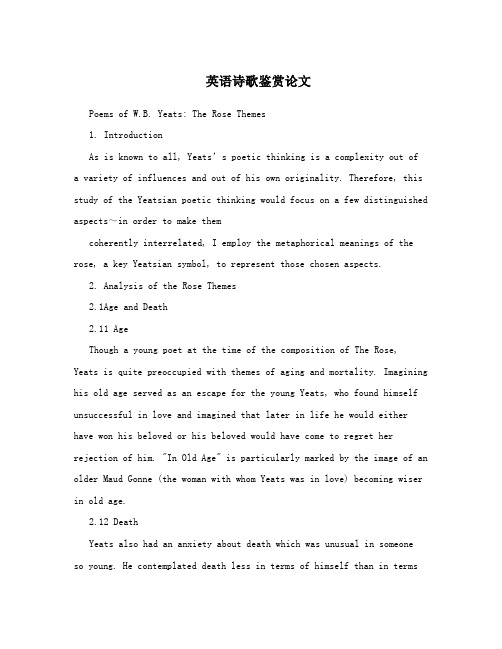
英语诗歌鉴赏论文Poems of W.B. Yeats: The Rose Themes1. IntroductionAs is known to all, Yeats’s poetic thinking is a complexity out of a variety of influences and out of his own originality. Therefore, this study of the Yeatsian poetic thinking would focus on a few distinguished aspects~in order to make themcoherently interrelated, I employ the metaphorical meanings of the rose, a key Yeatsian symbol, to represent those chosen aspects.2. Analysis of the Rose Themes2.1Age and Death2.11 AgeThough a young poet at the time of the composition of The Rose,Yeats is quite preoccupied with themes of aging and mortality. Imagining his old age served as an escape for the young Yeats, who found himself unsuccessful in love and imagined that later in life he would either have won his beloved or his beloved would have come to regret her rejection of him. "In Old Age" is particularly marked by the image of an older Maud Gonne (the woman with whom Yeats was in love) becoming wiser in old age.2.12 DeathYeats also had an anxiety about death which was unusual in someoneso young. He contemplated death less in terms of himself than in termsof his loved ones. When Maud Gonne travel to France as a convalescent, a worried Yeats wrote "A Dream of Death." This meditation on Gonne's possible death is less of a nightmare than a dream comes true, as Yeats envisions himself being useful to her in death as he could not be in life. Yeats, therefore, views both aging and death as more or less positive forces.2.2 Irish MythologyThe Rose is rife with mythological references, from King Fergus to Conchubar to Diarmuid. Indeed, such mythic Irish figures populate nearly every poem in the [1]collection.Mythology operates as a theme in this collection in a number of ways. First and foremost it separates Yeats' poetry from British writing. British writers drew on Roman and Greek mythology - the mythology, in fact, of other (albeit ancient) imperialists. In choosing Irish mythology as his source of allusions and subjects, Yeats creates poetry distinct from that of Ireland's long-time oppressors. This compliments Yeats' desire to cultivate a poetic language suitable to Ireland alone.Moreover, Yeats' use of Irish mythological subjects allows him to avoid the political climate of his own day. Yeats, a moderate comparedto his beloved Maud Gonne, found his political beliefs to be a burden in his pursuit of love. In treating legendary figures, Yeats avoids the problem of referencing the complicated political environment that so tormented him.2.3 Irish NationalismNationalism in Ireland in the 1890s was in a complicated stage. Many die-hard Fenians (Republicans), including Maud Gonne, were more than willing to take armsagainst the British to gain their independence. Another group, including Yeats, took the more cautious parliamentary approach. This political party, called the Home Rule Party, was led by John Redmund and held that Ireland could gain independence [2]through legal means.Because this collection focuses so much on Maud Gonne, Yeats inevitably touches upon his political differences with his beloved. These differences, needless to say, affected their relationship negatively. Yeats feared that Gonne was more repulsed by his moderate politics than by his person.Thus, in some poems, such as "To Ireland in the Coming Times," Yeats seems to be willfully disassociating himself from the complex political fabric of his own era, instead hearkening to a simpler politics of ancient kings. Undoubtedly Yeats was drawn to these ancient mythic times anyway, but his interest takes on a sadness in the context of his relationship with the politics of his own day (and thus of his relationship with Gonne). Nationalist politics exist negatively in these poems, as the subject that Yeats doesn't want to address.2.4 Maud Gonne“A rose of love” refers to the rose as a symbol of love,Loveplayed allimportant part in Yeats ’s personal life as well as in his writing career,In return it isreflected in his poetry and philosophy,On one hand~his unrequited love for MaudGonne fills his poetry, especially those of his early phase~with ardent passion,Theunattainability of his frequently rejected courtship~however, sets a melancholy toneto his love poetry,Also in his early love poems the reader couldfind influence of the[3]courtly love tradition~which he received initially from the pre—Raphaelism,Onthe other hand~his romantic obsession to Gonne contributed considerably to the development of his symbolism,As Yeats himself mentioned~Gonne was the key tohis private symbolism,She is compared to apple blossom due to their commonbeauty and vitality,She is tactically referred to by mere description of her hair, her face~her eyes~her lips~or her “pilgrim soul”,She is the archetype of mostwomen images in Yeats ’s poetry, such as the Countess Cathleen~Helen of Troy,[4]Aengus’s dream lover~Oisin’s wife~Leda~etc,She is also present in manyother nonhuman symbols~including the rose~the tree~the swan~the phoenix~the eagle~etc,Furthermore~not only do those symbolspresent Yeats ’sbeloved in his own poetic way, but they are sufficient to have their own life with regard to their artistic value.The Rose of the WorldWHO dreamed that beauty passes like a dream?For these red lips, with all their mournful pride,Mournful that no new wonder may betide,Troy passed away in one high funeral gleam,And Usna's children died. (Adapted)Yeats wrote this poem to Maud Gonne, with whom he was deeply in love. He often compares her to Helen of Troy, arguing that her beauty, like Helen's, is capable of wrecking turmoil between nations. Indeed, as Gonne is a representative of Ireland, this comparison suggests that her beauty embodies the strife between Ireland and England, which is especially fitting given that Gonne was a fierce Irish nationalist. The reference to Usna's children in the same stanza likens her to Deirdre,an Irish heroine who was destined to bring suffering on the area of Ulster, [5]because too many men fell in love with her.3. ConclusionBy making use of the metaphorical meanings of the rose~this thesisis a studyof several chosen aspects of Yeats’s poetic thinking . Love drastically influenced Yeast’s writing, acting as his source that contributed considerably to the development of his symbolism~Yeats’s mysticism gave the philosophical quality to his poetry~Therefore~this study of Yeats’s poetic thinking might be useful to the Yeatsian scholarship,It is hoped that the thesis would be helpful to readers who seek for a better understanding of Yeats and his times.Works Cited[1] MacNeice, Louis. The Poetry of W.B. Yeats. New York: OxfordUP,1988.[2] Sidnell, Michael J. Yeats’s Poetry and Poetics. Basingstoke:Macmmillan,1996.[3]。
英文诗歌鉴赏英语作文
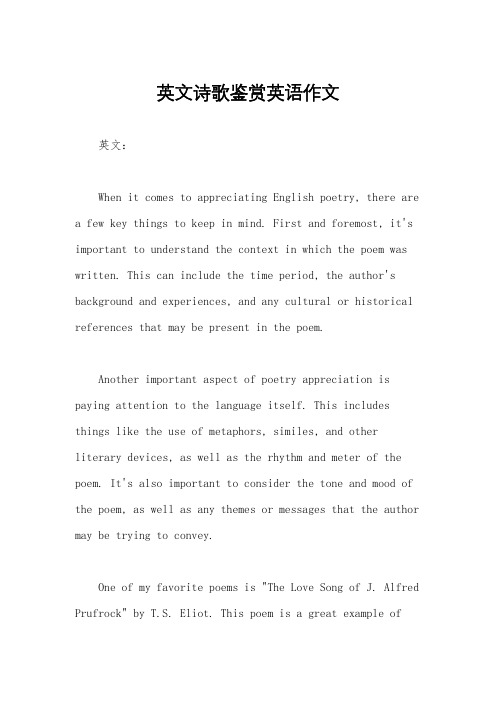
英文诗歌鉴赏英语作文英文:When it comes to appreciating English poetry, there are a few key things to keep in mind. First and foremost, it's important to understand the context in which the poem was written. This can include the time period, the author's background and experiences, and any cultural or historical references that may be present in the poem.Another important aspect of poetry appreciation is paying attention to the language itself. This includes things like the use of metaphors, similes, and otherliterary devices, as well as the rhythm and meter of the poem. It's also important to consider the tone and mood of the poem, as well as any themes or messages that the author may be trying to convey.One of my favorite poems is "The Love Song of J. Alfred Prufrock" by T.S. Eliot. This poem is a great example ofhow a skilled poet can use language to create a particular mood and atmosphere. The poem is full of vivid imagery and metaphorical language, which helps to create a sense of unease and uncertainty in the reader. The poem's use of repetition and fragmented syntax also adds to this sense of disorientation.Another example of a great poem is "Do Not Go Gentle into That Good Night" by Dylan Thomas. This poem is a powerful meditation on mortality and the human desire to cling to life. The poem's use of repetition and strong, declarative language helps to convey the urgency and intensity of the speaker's message. The poem's structure, which consists of five stanzas of three lines each followed by a final quatrain, also adds to its sense of power and momentum.中文:欣赏英语诗歌时,有几个关键点需要注意。
英语诗歌鉴赏的英文作文
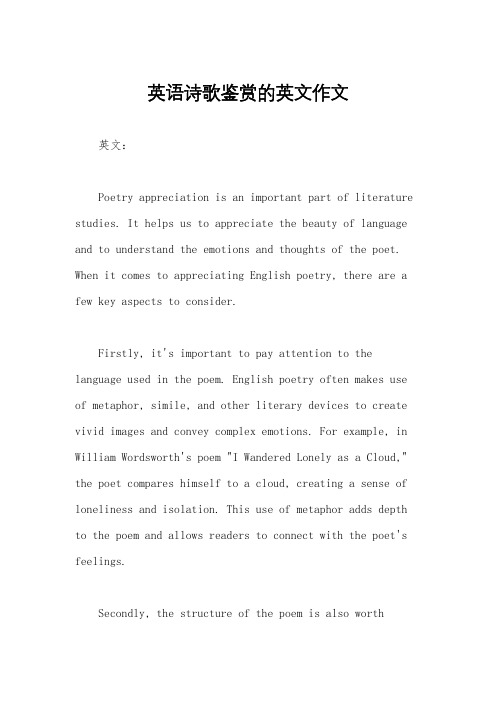
英语诗歌鉴赏的英文作文英文:Poetry appreciation is an important part of literature studies. It helps us to appreciate the beauty of language and to understand the emotions and thoughts of the poet. When it comes to appreciating English poetry, there are a few key aspects to consider.Firstly, it's important to pay attention to the language used in the poem. English poetry often makes use of metaphor, simile, and other literary devices to create vivid images and convey complex emotions. For example, in William Wordsworth's poem "I Wandered Lonely as a Cloud," the poet compares himself to a cloud, creating a sense of loneliness and isolation. This use of metaphor adds depth to the poem and allows readers to connect with the poet's feelings.Secondly, the structure of the poem is also worthconsidering. English poetry comes in various forms, such as sonnets, ballads, and free verse. Each form has its own unique characteristics and can evoke different emotions in the reader. For instance, a sonnet often follows a strict rhyme scheme and meter, creating a sense of order and harmony, while free verse allows for more freedom and experimentation. Understanding the form of a poem can help us to appreciate the poet's craftsmanship and the impact of their choices on the reader.Furthermore, the themes and symbols in the poem are important to consider. Many English poems explore universal themes such as love, nature, and the passage of time. For example, in Robert Frost's "The Road Not Taken," the poet uses the symbol of a road to represent the choices we make in life. By analyzing the themes and symbols in a poem, we can gain a deeper understanding of its meaning and significance.In addition, it's essential to consider the historical and cultural context in which the poem was written. English poetry has a rich tradition that spans centuries, and manypoems are influenced by the social and political events of their time. For example, the Romantic poets of the 19th century often celebrated the beauty of nature as a response to the industrialization and urbanization of their era. Understanding the historical and cultural context can enrich our appreciation of the poem and shed light on the poet's intentions.In conclusion, the appreciation of English poetry involves paying attention to the language, structure, themes, and context of the poem. By considering these aspects, we can gain a deeper understanding of the poet's work and the emotions and ideas they seek to convey.中文:诗歌鉴赏是文学研究的重要组成部分。
英文诗词赏析作文范文

英文诗词赏析作文范文1. This poem is a beautiful depiction of nature's wonders. The poet's vivid imagery transports the reader toa serene and tranquil setting, where they can almost feel the gentle breeze and hear the rustling leaves. The use of descriptive language such as "golden rays of sunlight" and "whispering melodies of the forest" creates a sensory experience that captivates the reader's imagination.2. The poem also explores the theme of love and longing. The poet's use of metaphors and symbolism adds depth to the emotions conveyed. The image of a "lonely star in the night sky" represents the yearning for a loved one, while the "withered rose" symbolizes the pain of lost love. These metaphors evoke a sense of nostalgia and melancholy, resonating with readers who have experienced similar emotions.3. The poem's structure is worth mentioning as well. It follows a traditional rhyme scheme, with alternating linesthat create a melodic flow. This rhythmic pattern adds to the musicality of the poem, enhancing its emotional impact. The use of enjambment, where a sentence or phrase runs over multiple lines, also adds a sense of movement and fluidity to the poem.4. Another notable aspect of this poem is its universal appeal. While the specific details and imagery may vary from reader to reader, the underlying themes of nature, love, and longing are relatable to all. This universality allows the poem to transcend cultural and linguistic barriers, making it accessible and meaningful to a wide range of audiences.5. Finally, the poem's brevity is a strength in itself. In just a few lines, the poet manages to convey a wealth of emotions and paint a vivid picture. This conciseness adds to the poem's impact, leaving a lasting impression on the reader. It also allows for multiple interpretations, as readers can fill in the gaps with their own experiences and emotions.Overall, this poem is a masterful piece of art that combines vivid imagery, emotional depth, and universal themes. Its beauty lies in its ability to transport the reader to another world, evoke strong emotions, and leave a lasting impression. It is a testament to the power of poetry in capturing the essence of the human experience.。
英文小诗歌鉴赏作文
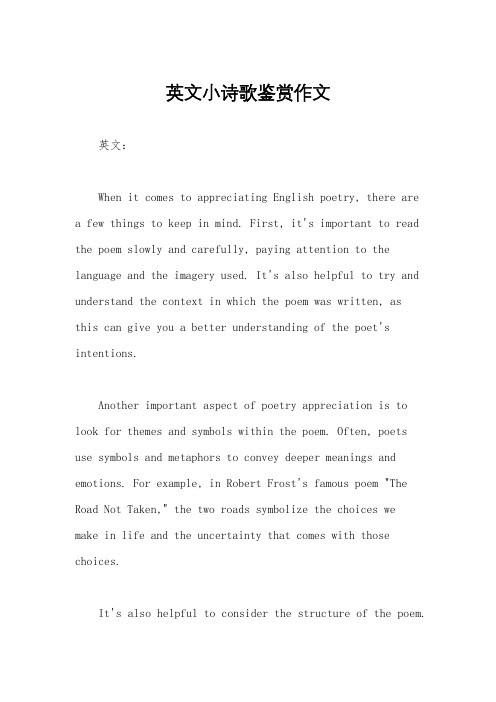
英文小诗歌鉴赏作文英文:When it comes to appreciating English poetry, there are a few things to keep in mind. First, it's important to read the poem slowly and carefully, paying attention to the language and the imagery used. It's also helpful to try and understand the context in which the poem was written, asthis can give you a better understanding of the poet's intentions.Another important aspect of poetry appreciation is to look for themes and symbols within the poem. Often, poets use symbols and metaphors to convey deeper meanings and emotions. For example, in Robert Frost's famous poem "The Road Not Taken," the two roads symbolize the choices we make in life and the uncertainty that comes with those choices.It's also helpful to consider the structure of the poem.Is it written in a specific form, such as a sonnet or a haiku? Does it have a rhyme scheme or a specific rhythm? These elements can add to the overall effect of the poemand give it a unique voice.Finally, don't be afraid to interpret the poem in your own way. Poetry is meant to be open to interpretation, and what one reader takes away from a poem may be differentfrom another reader's interpretation. The important thingis to engage with the poem and try to understand the emotions and ideas that the poet is trying to convey.中文:当涉及到欣赏英语诗歌时,有几点需要注意。
赏析诗歌英语作文
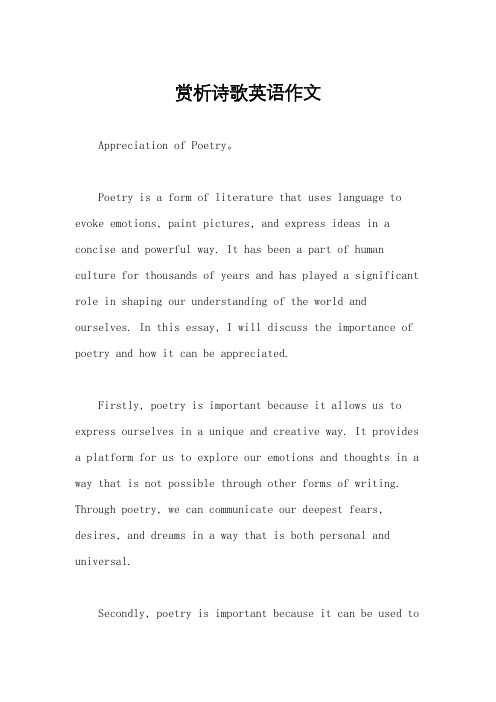
赏析诗歌英语作文Appreciation of Poetry。
Poetry is a form of literature that uses language to evoke emotions, paint pictures, and express ideas in a concise and powerful way. It has been a part of human culture for thousands of years and has played a significant role in shaping our understanding of the world and ourselves. In this essay, I will discuss the importance of poetry and how it can be appreciated.Firstly, poetry is important because it allows us to express ourselves in a unique and creative way. It provides a platform for us to explore our emotions and thoughts in a way that is not possible through other forms of writing. Through poetry, we can communicate our deepest fears, desires, and dreams in a way that is both personal and universal.Secondly, poetry is important because it can be used toconvey important messages and ideas. Many poets use their work to comment on social and political issues, and to challenge the status quo. Through their words, they can inspire change and encourage people to think critically about the world around them.Thirdly, poetry is important because it can be appreciated on many levels. On a surface level, we can enjoy the beauty of the language and the way it sounds. But on a deeper level, we can appreciate the meaning behind the words and the emotions they evoke. We can also appreciate the technical skill of the poet, and the way they use language to create meaning.To appreciate poetry, it is important to read it with an open mind and a willingness to engage with the words on a deeper level. It is also helpful to read poetry out loud, as this can help us to appreciate the rhythm and sound of the language. Finally, it is important to read widely and to explore different styles and genres of poetry, as this can help us to develop a deeper understanding and appreciation of the art form.In conclusion, poetry is an important and powerful form of literature that has the ability to evoke emotions,convey important messages, and be appreciated on many levels. By reading and engaging with poetry, we can develop a deeper understanding of ourselves and the world around us.。
英文诗词鉴赏作文范文
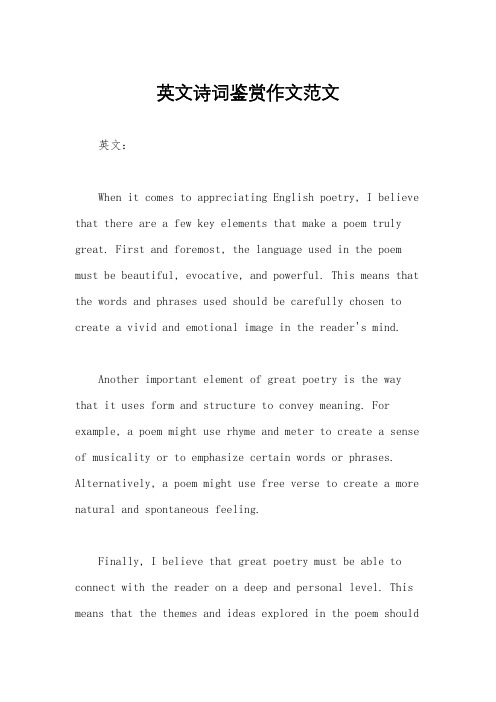
英文诗词鉴赏作文范文英文:When it comes to appreciating English poetry, I believe that there are a few key elements that make a poem truly great. First and foremost, the language used in the poem must be beautiful, evocative, and powerful. This means that the words and phrases used should be carefully chosen to create a vivid and emotional image in the reader's mind.Another important element of great poetry is the way that it uses form and structure to convey meaning. For example, a poem might use rhyme and meter to create a sense of musicality or to emphasize certain words or phrases. Alternatively, a poem might use free verse to create a more natural and spontaneous feeling.Finally, I believe that great poetry must be able to connect with the reader on a deep and personal level. This means that the themes and ideas explored in the poem shouldbe universal and timeless, and that they should resonatewith the reader's own experiences and emotions.One example of a poem that I believe embodies all of these qualities is "The Waste Land" by T.S. Eliot. This poem is not only beautifully written, but it also uses a variety of different forms and structures to create a sense of fragmentation and disconnection. Additionally, the themes of disillusionment, decay, and spiritual emptiness explored in the poem are still relevant and poignant today.中文:谈到欣赏英文诗歌,我认为有几个关键元素使一首诗真正伟大。
英文诗篇赏析作文范文初中
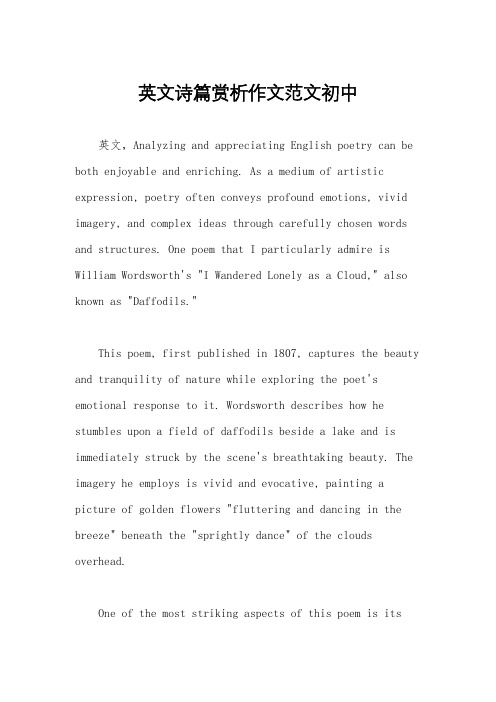
英文诗篇赏析作文范文初中英文,Analyzing and appreciating English poetry can be both enjoyable and enriching. As a medium of artistic expression, poetry often conveys profound emotions, vivid imagery, and complex ideas through carefully chosen words and structures. One poem that I particularly admire is William Wordsworth's "I Wandered Lonely as a Cloud," also known as "Daffodils."This poem, first published in 1807, captures the beauty and tranquility of nature while exploring the poet's emotional response to it. Wordsworth describes how he stumbles upon a field of daffodils beside a lake and is immediately struck by the scene's breathtaking beauty. The imagery he employs is vivid and evocative, painting a picture of golden flowers "fluttering and dancing in the breeze" beneath the "sprightly dance" of the clouds overhead.One of the most striking aspects of this poem is itsuse of personification. Wordsworth personifies the daffodils, describing them as "dancing" and "tossing their heads in sprightly dance." This anthropomorphic portrayal adds a sense of life and vitality to the flowers, enhancing the poem's overall sense of wonder and joy.Furthermore, the poem's simple yet effective language and rhythmic structure contribute to its enduring appeal. The use of iambic tetrameter lends a musical quality to the verse, echoing the gentle swaying of the daffodils in the breeze. Additionally, the rhyme scheme (ABABCC) provides a sense of harmony and unity, mirroring the harmony found in nature itself.The central theme of "I Wandered Lonely as a Cloud" is the power of nature to inspire and uplift the human spirit. Through his encounter with the daffodils, Wordsworth experiences a profound sense of joy and connection to the natural world. The poem serves as a reminder of the restorative power of nature and the importance of taking time to appreciate its beauty amidst the busyness of everyday life.中文,欣赏和分析英文诗歌既令人愉悦又富有启发性。
诗歌欣赏英文作文

诗歌欣赏英文作文Poetry is a form of art that has been around for centuries. It is a way for people to express their emotions, thoughts, and experiences through words. While some mayfind it difficult to appreciate poetry, I find it to be a beautiful and powerful form of communication.The beauty of poetry lies in its ability to convey complex emotions and ideas in a concise and impactful manner. A single line of poetry can contain layers of meaning and evoke powerful emotions in the reader. For example, the line "I wandered lonely as a cloud" from William Wordsworth's poem "Daffodils" creates a vivid image of isolation and melancholy.Another aspect of poetry that I appreciate is its useof figurative language. Metaphors, similes, and personification are just a few examples of the ways inwhich poets use language to create a deeper meaning. For instance, in Maya Angelou's poem "I Know Why the Caged BirdSings," the caged bird is a metaphor for the oppression experienced by African Americans during segregation.In addition to its emotional impact, poetry can also be a form of social commentary. Many poets use their work to address issues such as inequality, injustice, and discrimination. For example, Langston Hughes' poem "Harlem" explores the consequences of deferred dreams for African Americans during the Civil Rights Movement.Finally, I appreciate poetry for its ability to connect people across time and space. Whether reading a poemwritten centuries ago or one composed by a contemporary poet, the emotions and experiences expressed in the work are often universal. Reading poetry can be a way to connect with others and gain a deeper understanding of the human experience.In conclusion, poetry is a powerful and beautiful form of art that has the ability to evoke strong emotions, convey complex ideas, and connect people across time and space. While it may not be for everyone, I believe thatthose who take the time to appreciate poetry will find it to be a rewarding and enriching experience.。
诗歌赏析英文作文
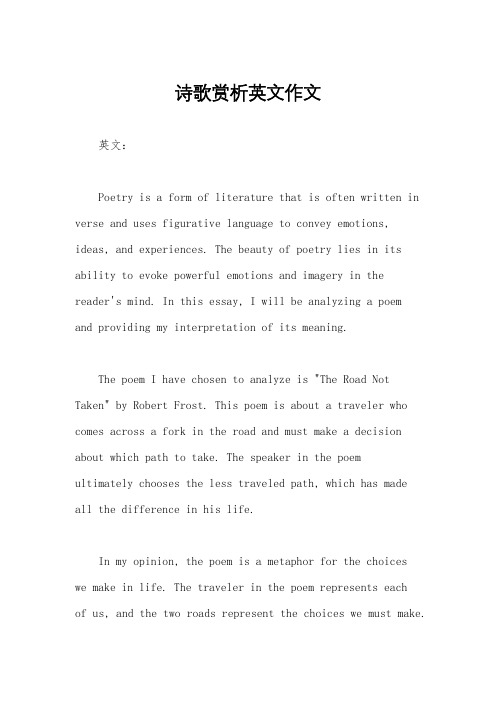
诗歌赏析英文作文英文:Poetry is a form of literature that is often written in verse and uses figurative language to convey emotions, ideas, and experiences. The beauty of poetry lies in its ability to evoke powerful emotions and imagery in thereader's mind. In this essay, I will be analyzing a poemand providing my interpretation of its meaning.The poem I have chosen to analyze is "The Road Not Taken" by Robert Frost. This poem is about a traveler who comes across a fork in the road and must make a decision about which path to take. The speaker in the poemultimately chooses the less traveled path, which has madeall the difference in his life.In my opinion, the poem is a metaphor for the choiceswe make in life. The traveler in the poem represents eachof us, and the two roads represent the choices we must make.The fact that the speaker chooses the less traveled path suggests that he is someone who is willing to take risks and make unconventional choices. This is a trait that is often associated with successful and fulfilled individuals.Furthermore, the poem also suggests that the choices we make in life can have a profound impact on our future. The speaker notes that taking the less traveled path has made all the difference in his life. This suggests that the choices we make can lead to different outcomes and experiences.In conclusion, "The Road Not Taken" is a powerful poem that speaks to the human experience of making choices and taking risks in life. The metaphor of the two roads is a powerful one, and the poem's message is one that is relevant to all of us.中文:诗歌是一种文学形式,通常用诗歌形式写作,并使用比喻语言来传达情感、思想和经验。
欣赏诗歌英语作文
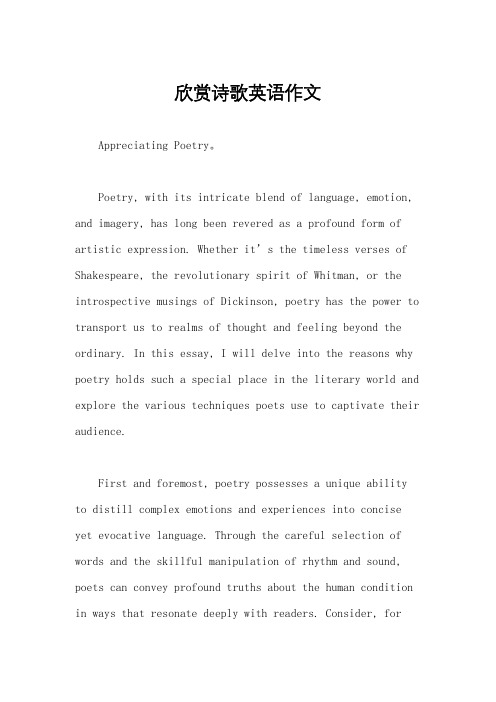
欣赏诗歌英语作文Appreciating Poetry。
Poetry, with its intricate blend of language, emotion, and imagery, has long been revered as a profound form of artistic expression. Whether it’s the timeless verses of Shakespeare, the revolutionary spirit of Whitman, or the introspective musings of Dickinson, poetry has the power to transport us to realms of thought and feeling beyond the ordinary. In this essay, I will delve into the reasons why poetry holds such a special place in the literary world and explore the various techniques poets use to captivate their audience.First and foremost, poetry possesses a unique ability to distill complex emotions and experiences into concise yet evocative language. Through the careful selection of words and the skillful manipulation of rhythm and sound, poets can convey profound truths about the human condition in ways that resonate deeply with readers. Consider, forexample, the haunting beauty of T.S. Eliot's "The Waste Land," which explores themes of disillusionment and despair in the aftermath of World War I. Through its fragmented imagery and shifting perspectives, the poem captures the sense of fragmentation and alienation that pervaded the post-war era, leaving a lasting impression on readers.Furthermore, poetry often serves as a mirror reflecting the cultural and historical context in which it is written. From the Romantic poets' celebration of nature to the Beat Generation's critique of consumerism and conformity, poetry has been a vehicle for social commentary and cultural critique throughout history. By examining the themes and motifs present in a particular poem, readers can gain insight into the values, beliefs, and concerns of the society that produced it. For instance, Langston Hughes' "Harlem" explores the deferred dreams of African Americans in the face of racial injustice, giving voice to the frustrations and aspirations of a marginalized community.In addition to its thematic richness, poetry also dazzles with its formal experimentation and aestheticinnovation. From traditional forms like the sonnet and villanelle to more avant-garde techniques like free verse and concrete poetry, poets have continually pushed the boundaries of language and form in their quest for artistic expression. Consider, for example, the groundbreaking work of e.e. cummings, whose playful manipulation of syntax and punctuation challenged conventional notions of grammar and syntax, inviting readers to see the world anew through fresh eyes.Moreover, poetry has the power to forge connections across time and space, bridging the gap between individuals separated by geography, culture, and even centuries. Through the act of reading and interpreting poetry, readers are able to enter into a dialogue with the poet, engagingin a shared exploration of the human experience. Whetherit's the ancient verses of Sappho or the contemporarylyrics of Rupi Kaur, poetry has the ability to transcend barriers of language and culture, forging bonds of empathy and understanding between people from diverse backgrounds.In conclusion, poetry occupies a unique and cherishedplace in the literary landscape, offering readers a window into the depths of the human soul. Through its powerful language, rich symbolism, and timeless themes, poetry has the power to inspire, challenge, and uplift us, enriching our lives in ways both profound and enduring. So let us continue to celebrate and cherish the art of poetry, recognizing its ability to illuminate the beauty and complexity of the world we inhabit.。
- 1、下载文档前请自行甄别文档内容的完整性,平台不提供额外的编辑、内容补充、找答案等附加服务。
- 2、"仅部分预览"的文档,不可在线预览部分如存在完整性等问题,可反馈申请退款(可完整预览的文档不适用该条件!)。
- 3、如文档侵犯您的权益,请联系客服反馈,我们会尽快为您处理(人工客服工作时间:9:00-18:30)。
Enjoying English Poetry Course EssayStudent’s Name: Class Number: Date: 2015/12/21Wordsworth’s View on Nature Based on the Reading of I Wandered Lonely asa CloudChe HongyuWordsworth was a British poet in the 19th century and the poet laureate since 1843 till his death in 1850. He was born and grew up in the English Lake District and the beautiful scenery of his hometown nurtured his deep love for nature and his purpose of praising nature in his work. He called himself “Prophet of Nature” in The Prelude, and claimed that prophets of nature “will speak a lasting inspiration, sanctified by reason, blest by faith: what we have loved, others will love and we will teach them how”(Wordsworth, 1979: 482), by which he means he, as a nature worshipper, will write about his love for nature in his work and show the readers what he loves about nature, so as to teach them how to love nature and evoke their love for nature.This essay will analyze the poem I wandered Lonely as a Cloud from the aspects of writing background, metrical patterns, figures of speech and images so as to examine William Wordsworth’s view on nature.I Wandered Lonely as a Cloud was written in 1804 and believed to be one of the most beautiful poems written on nature. The poet wrote this poem based on his experience on April 15th, 1802. That day, Wordsworth and his sister Dorothy Wordsworth were walking in the Lake District, to quote Dorothy in Grasmere Journals, “It was a threatening misty morning-but mild. We set off after dinner…The wind was furious & we thought we must have returned…We first rested in the largeBoat-house, then under a furze Bush…The wind seized our breath the Lake was rough. We rested again in the Water Millock Lane…We got over into a field to avoid some cows…When we were in the woods beyond Gowbarrow park we saw a few daffodils close to the water side” (Abrams, 2000: 391). It was clear that that day was a windy one, Wordsworth and his sister set off for a walk after dinner but was frustrated by furious wind. They rested in the Boathouse, under a bush, and in the Water Millock Lane and they walked on against the wind and when they arrived at the woods, they saw the daffodils. The daffodils were beautiful and vast, “there was a long belt of them along the shore, about the breadth of a country turnpike road (Abrams, 2000: 391)”. They did not expect to see such beautiful daffodils in such a multitude on such a rough day. “I never saw daffodils so beautiful they grew among the mossy stones about & about them, some rested their heads upon these stones as on a pillow for weariness & the rest tossed & reeled & danced & seemed as if they verily laughed with the wind that blew upon them over the lake, they looked so gay ever glancing ever changing (Abrams, 2000: 391)”. The daffodils are not only beautiful but also cheerful, such natural beauty cheered up the two travelers on such a windy cold day. Two years later, Wordsworth wrote the poem I Wandered Lonely as a Cloud to praise nature.Obviously, the theme of the poem is “nature is beautiful and wise” as shown in daffodils. To show the beauty and charm of daffodils, the poet creates a musically beautiful poem. This poem was written in iambic tetrameter, with a rhyme scheme of ababcc. All the four stanzas follow the same metrical pattern, and the whole poem is actually an ode to daffodils of the Horatian type. Tetrameter, shorter than pentameter, creates a cheerful rhythm and the use of traditional iambic meter ensures the soothing effect of musicality of the poem. The long vowels of au, i:, ai, ei, a: also create a comforting, calming effect on the readers, beautifully soothing. The repetition of the lateral l sound adds to this loving and peaceful effect. The poet’s use of the euphony shows how much he wants to show and convey to the readers the beauty of daffodils, which is also the beauty of nature.Apart from the musical beauty, the poet uses various figures of speech and images to further show the beauty and cheerfulness of the daffodils. At the beginning of the poem, the speaker was seen as a lonely wanderer in the hill, who was compared to “a cloud that floats on high o’er vales and hills”. But the appearance of the daffodils greatly changed his melancholy mood. He did not see just one or twodaffodils, but a great many, “a crowd, a host, of golden daffodils”, “continuous as the stars…on the milky way”, “they stretched in never-ending line”, “ten thousand saw I at a glance”. The images of “crowd”, “host”, “never-ending line”showed the non-loneliness of the flowers which instantly impressed the speaker. The daffodils are not only impressive in number, but also extremely cheerful, happy and inspiring. The kinesthetic images of “fluttering”, “dancing’, “shine and twinkle”, “tossing their heads in spritely dance” depicted vivid pictures of this “jocund” company.Nature is beautiful, as shown in the poem, but not only so. Nature teaches people about the wisdom of life too. The daffodils are blooming in the rough wind, dancing, shining, fluttering against the bad weather, which tells the speaker a truth about nature: nature is naturally merry. The wind is rough, that is what the wind is; this does not stop the daffodils from remaining happy and celebrating life. The speaker was influenced by the cheerfulness of nature and forgot his loneliness. Even upon retrospection, when the speaker was “in vacant or in pensive mood”, the wisdom taught by nature’s beauty still came back to him, “they flash upon that inward eye/Which is the bliss of solitude” and this inspired him and worked a wonder on him, and he became happy.To conclude, Wordsworth loves nature and believes nature is not only beautiful, but also wise. He, as a poet, takes “praising nature” as his mission and tries to be the “prophet of nature”. He uses the persona to express his faith in and love for nature in this poem. He believes if people try to appreciate nature’s beauty, take in nature’s wisdom, humbly accept nature’s nurturing, people will be wise and happy.Note: All the quotations of the poem I Wandered Lonely as a Cloud are from《英语诗歌欣赏》,蒲度戎主编,2008,重庆:重庆大学出版社。
